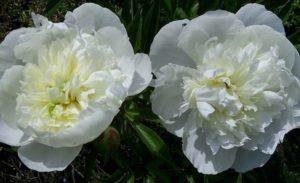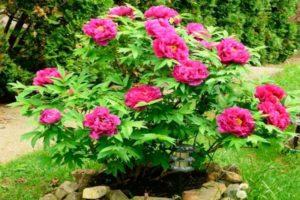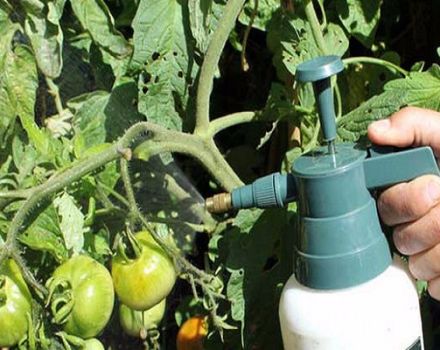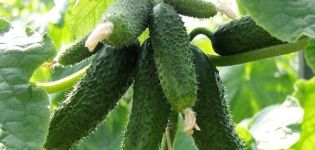Characteristics and description of the Kansas peony variety, planting and care rules
The popularity of the Kansas peony variety is gaining momentum. In beauty it is close to a rose: a bush with double dense inflorescences will become the true king of the flower bed, its visual center. In addition to the spectacular exterior, the peony is unpretentious, which allows it to be grown outdoors, on a balcony or window. Without requiring special expenses, the flower will delight the owners with chic, spherical buds.
Description and features
The Kansas cultivar is classified as a herbaceous peony. The plant is small, up to 1 meter, decorated with lush balls of flowers about 20 centimeters in diameter. Blooms in May, continuing to produce buds until the end of June. It grows on almost any soil, does not require an annual transplant. By the way, in one place a bush, under favorable conditions, can exist for a couple of decades.
It is believed that on fertilized soil, the peony will bloom without problems for 3-4 years. The plant is hardened, tolerates frost on the ground up to minus 30 degrees. Branches with flowers are stored for a long time in a cut form, they will stand on the table in a vase of water for up to 7 days.
Landing
There are several simple rules for planting a peony. They are easy to follow, but easy to remember:
- Choose sunny, well-lit places for your future flower garden. Kansas tolerates shade worse than excess light. Therefore, it is not recommended to place bushes near other plants, buildings shading peonies. Compliance with this requirement will ensure adequate circulation of fresh air.
- The peony has no special complaints about the soil, but clay is preferable. Additionally, the presence of nutrients is necessary, they will ensure the normal development of the bush. If there is no ready-made soil mixture with the required characteristics, it is prepared independently. To do this, a small amount of clay is added to sandy soils. They do the opposite with clayey, mixing sand with them.
The optimal time for planting a peony is autumn. It is better to carefully approach the planting site so that in the future the plant does not have to be hastily transferred to another site.
Seat selection
The future place of "residence" of the plant will affect its growth, flowering, normal existence. Planting a peony in the shade, among tall trees blocking the sun, is undesirable, since it will negate the gardener's attempts to achieve the ovary of buds.
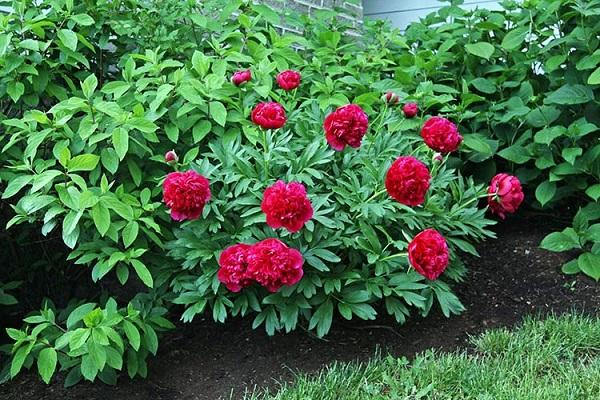
Selection and preparation of planting material
Since plant division is used more often than other methods for reproduction, the choice of planting stock is started in the fall, using 3-4-year-old bushes.The requirement for the obtained seedlings is as follows: root length - up to 15 centimeters, at least 3 buds. First, a peony donor bush is excavated. The tuberous part is carefully separated from the earthen coma, transferred to a cool, dark place, and covered. After about 2-3 hours, pruning is performed, removing damaged or diseased areas, dividing the peony bush into seedlings.
Another popular way to propagate peonies is cuttings. For this, a healthy and strong shoot is chosen on the bush. It is carefully cut into cuttings, leaving 2 internodes on each. Further, the seedlings are briefly soaked in a growth stimulator (Heteroauxin), rooted in the ground and covered with a film.
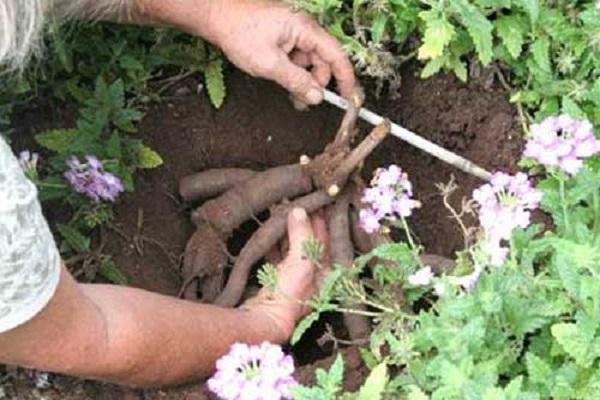
How to prepare the ground
The landing hole dug at the landing site will have to be filled with a special mixture. It includes:
- seasoned humus (a pair of buckets);
- bone meal (300 grams), it is permissible to replace with superphosphate;
- ash or sulphate of potassium, magnesium (300 grams).
Fertile land is added to this composition. If the soil is heavy, it is diluted with peat (sand). In sandy soils, it is necessary to fall asleep about a bucket of clay, this will balance their structure. With the finished conglomerate, the pit is filled by about a third, the rest is left for the soil fertilized with minerals.
Timing
The optimal planting time is autumn, from late August to early October. In exceptional cases, the bushes are planted in early spring, at the end of winter in a large pot or a 3-liter glass jar. The plant remains in this form until the arrival of heat. As soon as the air warms up to a temperature of 10 degrees, "preserved" peonies are planted in the ground.
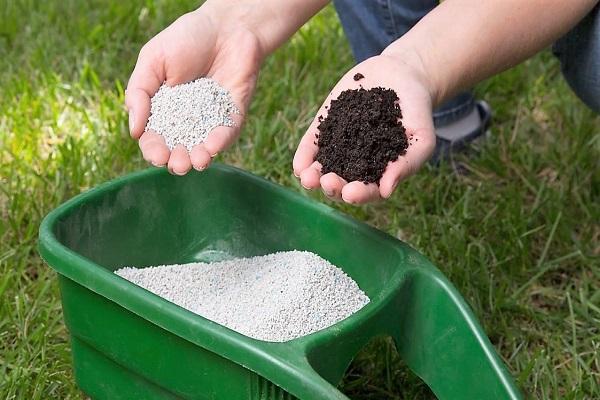
Landing scheme
When planting plants, a step of 1 meter is maintained between neighboring bushes. Planting too often will lead to the fact that the flowers will interfere with each other's harmonious development. In addition, they do not have enough moisture or nutrients in the soil.
Care
Caring for the Kansas variety consists in timely watering, fertilization with mineral complexes, prevention of diseases or pests, mulching.
Watering
Flowers are moderately hygrophilous: for them, overflow can lead to more sad consequences than drought. Typically, each plant uses up to 3 buckets of water. The procedure is repeated every 10 days. In the spring, when sap flow begins, peonies especially need regular watering.
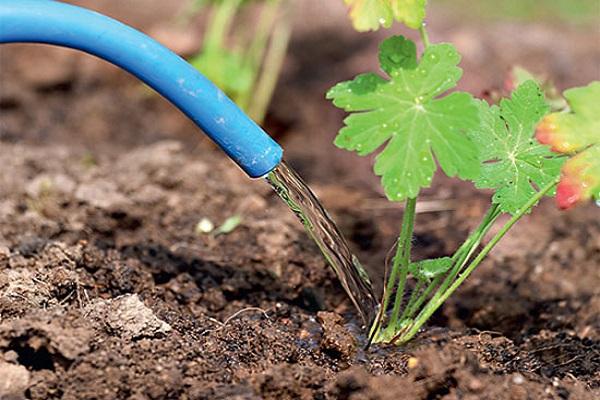
Loosening and weeding
After the flowering of peonies is complete, standard procedures are performed - loosening the soil, weeding from weeds. Sometimes this procedure is combined with feeding. Loosening is also useful after rain, to ensure the permeability of the soil, the plant receives nutrients.
Top dressing
During the growing season, Kansas is fed twice: the first time with organic matter (at the beginning or end of the season), the second with minerals, before the formation of inflorescences. The growth of young shoots takes a lot of energy, so fertilization is required. This can be ammonium nitrate (about 15 grams per bucket of water).
The best time for the procedure is evening. When feeding "adult" plants with deeply rooted roots, it is recommended to carefully drill several wells up to half a meter deep around the bush, into which water-soluble fertilizers will be poured.

Diseases and pests
Peonies are susceptible to pest attacks, as well as garden diseases. Each danger has its own methods of struggle, sometimes tough. To protect against insects, plants are treated with fungicides.
Gray rot
The source of gray rot on peonies is a fungus that infects roots, stems, leaves. Depending on the degree of damage, chemical treatment is used, removal of damaged parts followed by burning, deep loosening in the fall.
Rust
Brown, reddish spots are a symptom of the disease. If you do not intervene, the spores will spread to neighboring areas, affecting other plants. As a preventive measure, spraying with Bordeaux liquid is used. Affected leaves are separated, collected in heaps and burned.
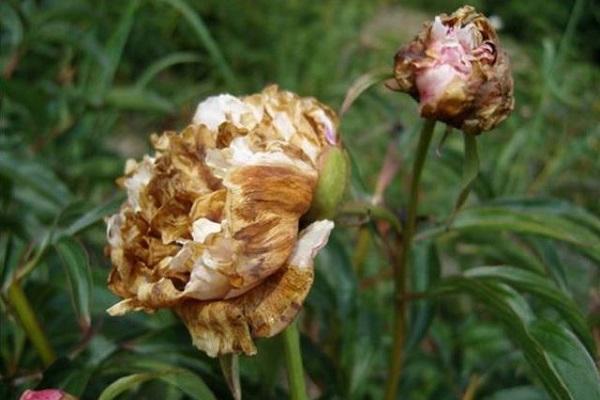
Transfer
Transplanting is not a mandatory procedure for young plants. This is necessary if the place for placing the flower bed is unsuccessfully chosen, when dividing an overgrown bush. They are engaged in transplanting peonies in the fall, carefully removing the plant along with an earthen clod. You can rinse under running water, being careful not to damage the roots. Then the bush is left in the air so that it wilts, after which they proceed to pruning or dividing.
Mulching
Filling the root zone with a layer of dry twigs or compost (mulch) allows you to preserve nutrients in the soil. The main thing is that fungal spores do not develop on this fertile soil.
Pruning
Autumn is the best time to prune peonies. At this time, the stems are cut short. If another, earlier season is chosen for the procedure, then they try to leave strong shoots with 3-4 leaves in the aboveground part.
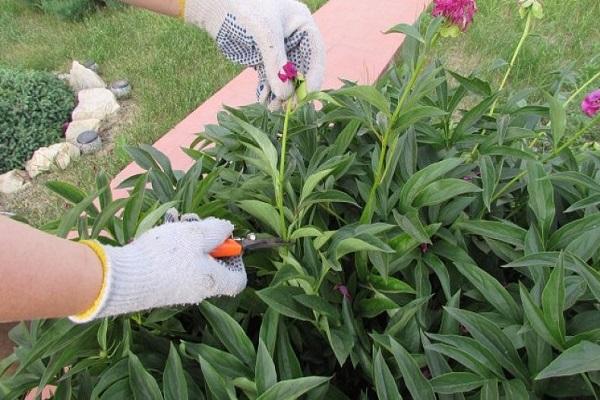
What to do when bloomed
When the peonies have bloomed, dry leaves and buds are removed, the soil is loosened, and top dressing is also applied.
Reproduction
Reproduction is carried out by cuttings, layering, dividing the bush, seeds.
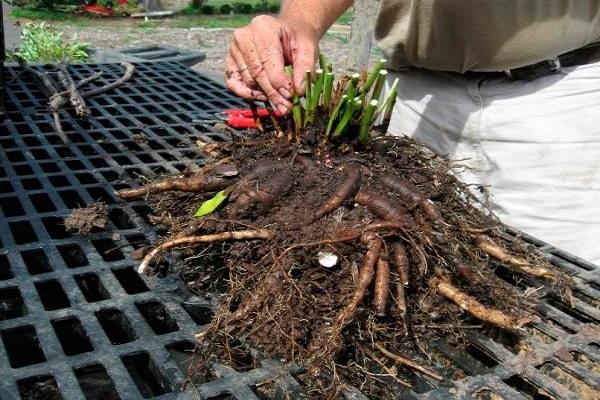
Beauty and benefits
The Kansas Peony is a complete, beautiful plant with a characteristic lush flowering. With reasonable care (and the plant does not require so much), bushes with bright buds will decorate a balcony, become a highlight in the design of a flower bed or garden plot.
